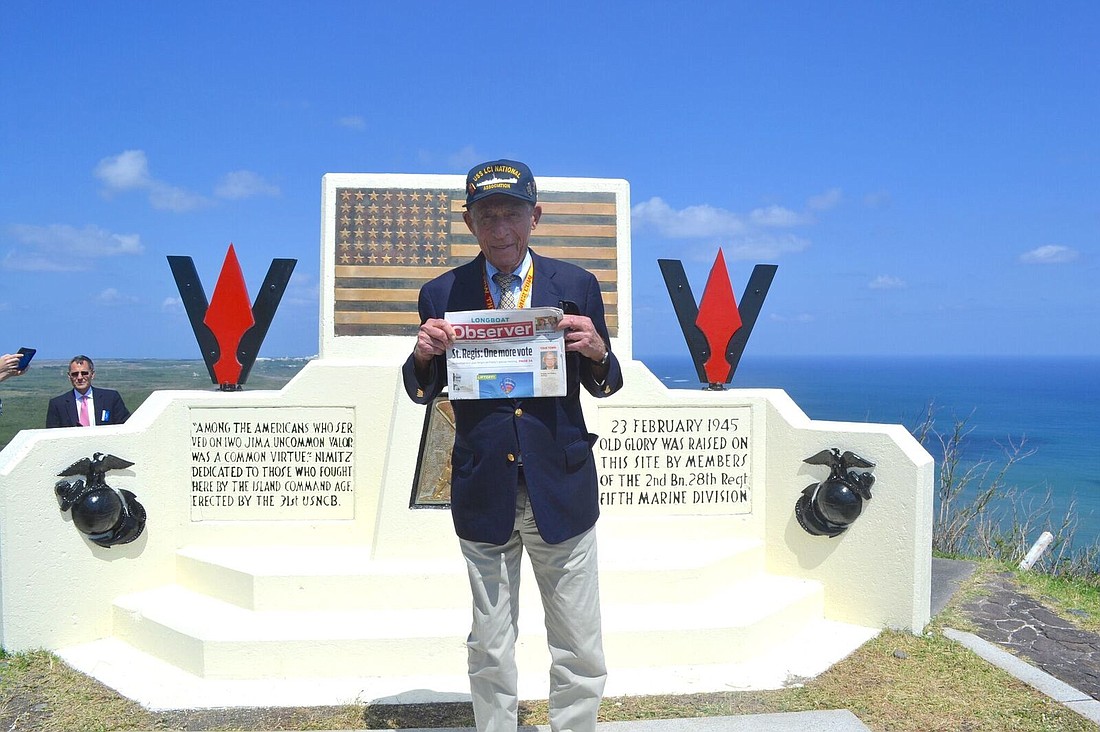- April 30, 2025
-
-
Loading

Loading

It took me 73 years, but I finally went back to Iwo Jima, generally regarded as the fiercest fight in the Pacific Theater of World War II and the site of the iconic flag-raising photo.
On Feb. 19, 1945, I arrived on an LCI (Landing Craft Infantry) at age 18. On March 24, 2018, I arrived on a United Airlines 737 chartered by the National WWII Museum for its “Victory in the Pacific” tour.
Over the intervening 73 years, I got as far as California twice, only to cancel. This time, my neighbor Ed Rhawn sent me a brochure, and I realized that I should go. The Japanese permit visitors once each year for a Reunion of Honor ceremony around the anniversary of truce on the island.
Of 140 trip participants, about a dozen were veterans of the Pacific campaign. Four had been at Iwo. The oldest was Keith Renstrom, 98, traveling with
his family. The youngest were my age, almost 92. Everyone treated us like rock stars. It’s the only time in my life I was ever asked for an autograph.
This was a big trip from March 16-26. It convened in Honolulu and my partner Molly Schechter and I embarked from there, visiting Saipan, Tinian and Guam before Iwo Jima.
Saipan: We visited landing beaches, learned about Japanese pillbox construction, saw submerged Sherman tanks and visited the bomb magazine
used to supply Japanese planes that attacked Guam in 1941. The most moving stop was “Suicide Cliffs,” where thousands of Japanese civilians and soldiers ended their lives upon realizing that Saipan was lost.
Tinian: This island was a day trip from Saipan. We toured North Field, today a mixture of memorials with buildings and vehicles in various states of decay. The B-29s Enola Gay and Bockscar took off from here with their atomic bombs for Hiroshima and Nagasaki. There are mock-ups of Fat Man and Little Boy on display, and we saw the pits from which they were loaded.
Guam: Our base in Guam was the Dusit Thani, a large, Thai resort. Guam had been a U.S. territory since the end of the Spanish-American War in 1898. The Japanese attacked on December 8, 1941 (the same day as Pearl Harbor on the other side of the International Date Line). Even after a 13-day preparatory bombardment, the Marines and the Army’s 7th Infantry Division faced stiff resistance when they landed in 1944. We visited the Asan and Agat landing beaches and the Asan Bay Overlook, home to a memorial wall honoring the servicemen who died defending Guam in 1941, the liberators
who retook it in 1944 and the Guamanian soldiers and civilians who endured the Japanese occupation.
The “Victory in the Pacific/Iwo Jima Symposium” was a highlight. Richard Frank and Jon Parshall, our traveling historians, put a question to each of the WWII veterans. I told them my court-martial- for-falling- asleep-on- duty story and shared a favorite military musing titled “Why We Gather” that celebrates the lasting camaraderie among soldiers.
The 73rd Anniversary Commemoration of the Battle of Iwo Jima: Seventy-three years later, I was back on the island where 7,000 American military died, and 23,000 were wounded and 1,000 of the 20,000 Japanese survived.
Iwo Jima, renamed Iwo-to, is solely inhabited by Japanese Ground Self Defense Forces, and the annual Reunion of Honor is quite a production. About 120 U.S. Marines arrive a couple of weeks in advance to prepare.
The Reunion of Honor ceremony took place on a former battlefield. The Americans were on one side, the Japanese on the other and a joint band of
United States Marines and the Japan Ground Self Defense Force was in between. There was plenty of brass on both sides, two national anthems, two
color guards, and many speeches. I was honored to participate in a wreath-laying ceremony.
After the program, the Marines drove us up Mt. Suribachi where the famous flag raising took place. Then it was down to the beach.
The only thing visitors can take from the island is sand. But I took much more than that. The very air here is enriched by the courage, spirit and patriotism of those who served on both sides. I am proud to have been part of the force in 1945, and thrilled by the strength and kindness of the men and women of the United States Marine Corps at the Reunion of Honor.
I stayed close with a half dozen of my Navy shipmates for decades after the war. I am the only one still here and made this trip in their honor.
Perhaps most of all, I am grateful for that.